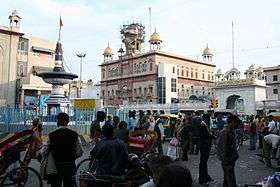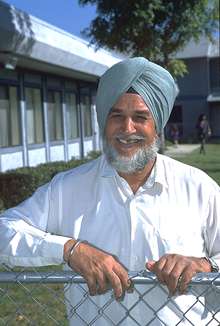Sikhism in India
|
Harmandir Sahib, located in Amritsar, Punjab is the holiest shrine of Sikhism. | |
| Total population | |
|---|---|
|
20,833,116 (2011)[1] Fourth largest Religion in India | |
| Regions with significant populations | |
|
Majority in Punjab, India. Significant populations in Chandigarh · Haryana · Delhi · Jammu & Kashmir · Rajasthan · Uttar Pradesh · Uttarakhand | |
| Languages | |
| Punjabi • Sindhi • Hindi • Telugu • Assamese • English |
Sikhism is India's fourth largest religion and has existed for 548 years, beginning with the birth of its founder Guru Nanak. The Sikhs are predominantly located in Punjab, but also in many other parts of India. It is also the fifth largest religion in the world,[2][3] with 25 million followers in the world as of the year 2010.[4]
Prominent Sikhs in India
Though Sikhs are a small minority in India, the community occupies a significant place in the country. The current Chief Justice of India, Jagdish Singh Khehar, and the former Prime Minister of India, Dr. Manmohan Singh[5] are Sikh, as is former President of India Gyani Zail Singh. Almost every council of ministers in India has included Sikh representatives. Sikhs are also conspicuous in the Indian army, primarily because they formed the sword arm of the British empire. The only living Indian officer with a 5 star rank, Arjan Singh, is a Sikh. Sikhs have also led the Indian army through JJ Singh and the Indian Air Force was led by Air Chief Marshal Dilbagh Singh. Sikhs have been prominent in Indian sports, with the only Indian individual gold medalist in Olympics, Abhinav Bindra, being a Sikh. Similarly they occupy important official positions, like Deputy Chairman of the Planning Commission, Montek Singh Ahluwalia;[6] governor Surjit Singh Barnala. Sikhs are also known for entrepreneurial business in India. In the entertainment industry, singer Daler Mehndi, Diljit Dosanjh and Rabbi Shergill are Sikhs. Milkha Singh, also known as The Flying Sikh, is a former Indian track and field sprinter who was introduced to the sport while serving in the Indian Army. One reason for visibility of Sikhs in the Indian spectrum is the disproportionate role played by the Sikh community during the Indian freedom struggle, with Bhagat Singh remaining a youth icon to Indian youth.[7]

A Sikh place of worship is called Gurdwara. Sikhism does not support pilgrimage to holy sites because according to Sikhism, God is everywhere and not in any certain place.[8] The Harmandir Sahib in Amritsar in Punjab is a prominent Sikh Gurdwara.
Langar (the communal meal)
Sikhism emphasises community services and helping the needy. One of the distinct features of Sikhism is the common kitchen called Langar. In every Gurdwara there is a Langar . Every Sikh is supposed to contribute in preparing a communal meal in the free kitchen. The meals are served to all and are eaten sitting on the floor. Sikhism does not believe in holding fasts, for the body is God's present to the human being; and therefore humans must foster, maintain and preserve it in good, sound condition, unless fasting is done to foster the human body like healthy diets.

The Guru Granth Sahib
Guru Nanak was the founder of Sikhism and the first Sikh Guru. The last Guru, Guru Gobind Singh passed the Guruship of the Sikhs to the Eleventh and Eternal Guru of the Sikhs, the Guru Granth Sahib (the sacred text of Sikhism). It also includes the writings of the Sikh Gurus and the writings of Hindu and Muslims saints because all are equal in front of Waheguru. Many people in India believe that Sikhism is a derivation out of Hinduism because most of the rituals and verses which are written in the Guru Granth Sahib are associated with the Vedas. But on the otherside Guru Granth Sahib Ji clearly states that-
ਪੂਜਾ ਕਰਉ ਨ ਨਿਵਾਜ ਗੁਜਾਰਉ॥ ਏਕ ਨਿਰੰਕਾਰ ਲੇ ਰਿਦੈ ਨਮਸਕਾਰਉ॥੩॥
I do not perform Hindu worship services, nor do I offer the Muslim prayers. I have taken the One Formless Lord into my heart; I humbly worship Him there. ||3||
ਨਾ ਹਮ ਹਿੰਦੂ ਨ ਮੁਸਲਮਾਨ॥ ਅਲਹ ਰਾਮ ਕੇ ਪਿੰਡੁ ਪਰਾਨ॥੪॥
I am neither a Hindu, nor am I a Muslim. My body and breath of life belong to the Great Almighty (Allah-Raam). ||4||
Guru Gobind Singh Ji declared in the verses of Uggardanti:
ਦੁਹੂੰ ਪੰਥ ਮੈਂ ਕਪਟ ਵਿੱਦਯਾ ਚਲਾਨੀ॥ ਬਹੁੜ ਤੀਸਰਾ ਪੰਥ ਕੀਜੈ ਪਰਧਾਨੀ॥
Tho two paths (Vedic and Abrahamic) have become corrupt. O' Lord propagate and uplift the third path (Khalsa Panth).

Sikhs combat with the Mughals
Guru Tegh Bahadur Ji on the request of Kashmiri Pandits saved the people of India. Aurungzeb's religious policy was totally against Hindus, they had to pay more taxes than Muslims. Sir Mohd. Latif writes "He discouraged the teaching of the Hindus, burnt to the ground the great Pagoda near Delhi, and destroyed the temple of Bishnath at Benares, and the great temple of Dera Kesu rai at Mathura, said to have been built by Raja Narsingh deo, at the cost of 33 lakh rupees. The gilded domes of this temple were so high that they could be seen from Agra 54 km distant. On the site of temple he built a mosque at a great cost. About year 1690, the emperor issued an edict prohibiting Hindus from being carried in palanquins or riding on Arabian horses.
Khalsa Panth (Punjabi: ਖਾਲਸਾ ਪੰਥ khĝlsĝ panth) meaning: the worldwide community of Khalsa or Sikhs generally (baptised Sikhs are called "Khalsa"). It is a name given to the religious structure and the community that manages the affairs of the global Khalsa community. "Khalsa" refers to the entire group of people who have taken an active decision to follow the way of life laid down by Guru Gobind Singh, the tenth Sikh Guru; it is the way of the life managed by the Khalsa community, who are self-managed through their democratic and collective wishes. Since Vaisakhi 1699 when the Khalsa was first forged, this community has existed as a distinct group; completely involved in their own local societies but also aware of its social and spiritual responsibility as stipulated by the tenth master. Unlike, other societies, this group did not lay claim to territory or land and property, even when they had rightfully defeated their aggressive opponents. The Panth's aim are the same as that of Sikhi in general and one is just the distillation of the other. The Panth has always existed as a community within other social groups. So, you have had panthic members living as Khalsa in locations away from Punjab where the Khalsa was originally created. Today, you will find the Khalsa located in almost all the major countries of the world; living in harmony with their local societies but always aware of the underlying requirements of their spiritual masters.
Kesh: (Kesh is uncut hair) A Sikh is to maintain and adorn this natural God-given gift. To work with nature and not against it. The Kesh was covered with a turban, Keski or Chunni to keep it clean and manageable. The keski is regarded by some the kakkar instead of kesh.
Kanga (wooden comb) for the maintenance and ongoing upkeep of Kesh. A reminder to regularly maintain the body and mind in a clean and healthy state.
Kara (steel bracelet or slave bangle): Symbolises an unbreakable bond with God. It is a constant reminder that the Sikh is a slave of the Lord. He or she must only do His work in accordance with the Holy Scripture; to abstain for wrongdoing at all times.
Kachhera (cotton underwear) Standard, Naturally Comfortable, dignified attire reflective of modesty and control. A sign of a soldier; ever ready; dignified and highly mobile.
Kirpan (a small sword) A sign that a Sikh is a soldier in "Akal Purakh's (God's) Army" (Akal Purakh de fauj); to maintain and protect the weak and needy and for self-defence. Never to be used in anger.
Sikh population in India



As per the latest figures of 2011 census, India has Sikh Population of 2.08 crores which is only 1.72% of the country's total population.[9] Out of the total Sikhs in India, 77% are concentrated in state of Punjab. Sikhism is the dominant religion in Punjab, where it is followed by 58% of the population, the only Indian state where Sikhism is the majority faith.
Other states where Sikh population has some impact are U.T. of Chandigarh (13.11%), New Delhi (5.4%), Haryana (4.91%), Uttarakhand (2.34%), Rajasthan (1.27%), Jammu & Kashmir (1.87%).[10]
See also
References
- ↑ "Census 2011 Data: Sikhs Have Worst Male-Female Ratio, Christians Best - Aug 26,2015". outlookindia.com. 24 August 2015. Retrieved 26 August 2015.
- ↑ Johnson, Ixia (26 May 2015). "Highlander – Senate passes Sikh Genocide Resolution; elects new justice". Highlander. Retrieved 26 August 2015.
- ↑ "Hill Langar Raises Awareness About Sikh Faith". Hill Blotter. 4 August 2015. Retrieved 26 August 2015.
- ↑ "The Future of World Religions: Population Growth Projections, 2010-2050". Pew Research Center's Religion & Public Life Project. 2 April 2015. Retrieved 26 August 2015.
- ↑ "India Swears In 13th Prime Minister and First Sikh in Job". The New York Times. 23 May 2004.
- ↑ "India's Most Influential". 15 August 2007 – via www.time.com.
- ↑ IndiaToday.in (23 March 2015). "Bhagat Singh, a Sandhu Jat, was born in September 1907 to a Sikh family in Banga village, Jaranwala Tehsil in the Lyallpur district of the Punjab Province of British India (now in Pakistan).". IndiaToday.in. Retrieved 7 September 2015.
- ↑ Star, Brian Leaf Rockford Register (15 August 2015). "Sikhs condemn fasting, visiting places of pilgrimage, superstitions, worship of the dead, idol worship and other blind rituals.". Rockford Register Star. Retrieved 7 September 2015.
- ↑ "Religion Data - Population of Hindu / Muslim / Sikh / Christian - Census 2011 India".
- ↑ "Sikh Population in India".